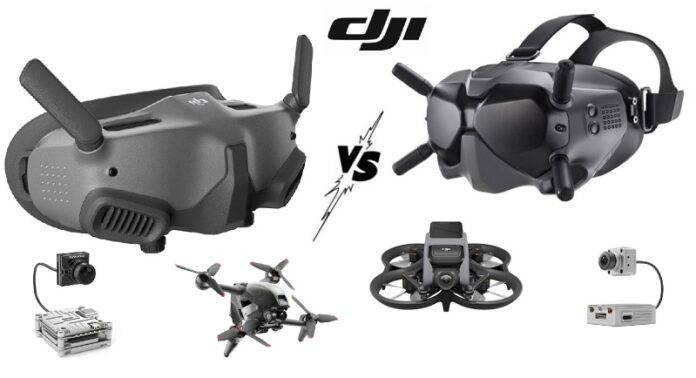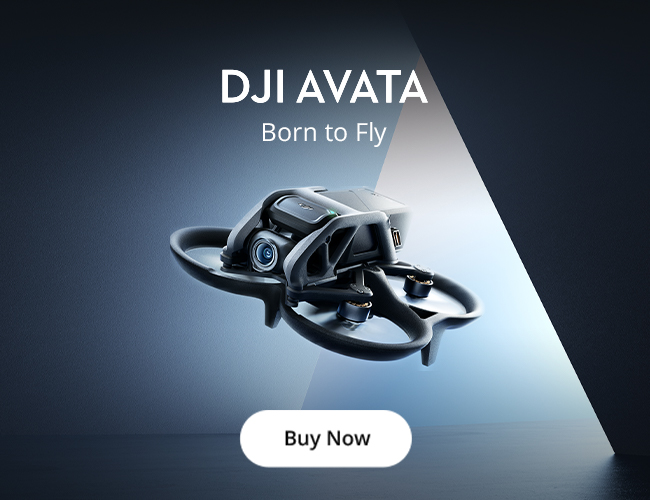On August 25, 2022, DJI officially revealed their first CineWhoop-style FPV drone, AVATA. The new quadcopter comes in a bundle with the redesigned Goggles 2. When DJI releases a new FPV product, everyone’s biggest concern is regarding backward compatibility with their existing gadgets. In addition to the in-depth comparison of the DJI Goggles 2 and FPV Goggles V2, this article will try to answer the following questions:
- Is the DJI Goggles 2 compatible with the DJI FPV drone?
- Can I use my old DJI FPV Goggles V2 with the new AVATA drone?
- Are my custom-made FPV drones using DJI Air Unit and Caddx Vista (RunCam Link) compatible with the DJI Goggles 2?
- Is the old DJI FPV transmitter compatible with the Goggles 2?
- Can I use the Goggles 2 with DJI Mavic 3 and Mini 3 Pro?
- What are the advantages and disadvantages of the Goggles 2 over the Goggles V2?
DJI Goggles 2 versus Goggles V2 comparison table (Similarities and Differences)
As you can see in the table below, there are some significant differences between the two DJI Goggles. The newly released AVATA headset has a much smaller form factor and a lighter design. By comparison, the Goggles 2 has a volume of about 1.4liter and a weight of just 290 grams, and the Goggles V2 has 2.5liter and weighs 420 grams.
| Goggles 2 | Goggles V2 | |
| Weight | 290 grams | 420 grams |
| Dimensions | 167×104×81 mm (antennas excluded) 197×104×105 mm (antennas included) |
184×122×110 mm (antennas excluded) 202×126×110 mm (antennas included) |
| Screen Size (single screen) | 0.49-inch | 2-inches |
| Resolution (per eye) | 1920×1080 | 1440 x 810 |
| Refresh Rate | 100 Hz | 144 Hz |
| Interpupillary Distance Range | 56-72 mm | 58-70 mm |
| Diopter Adjustment Range | -8.0 D to +2.0 D | N/A |
| Field of view (FOV) | 51° | 54° |
| Max Video Transmission Bitrate | 50 Mbps | 50 Mbps |
| Communication Frequency | 2.400-2.4835 GHz 5.725-5.850 GHz |
2.400-2.4835 GHz 5.725-5.850 GHz |
| Transmission Power (EIRP) | 2.4 GHz: < 30 dBm (FCC), < 20 dBm (CE/SRRC/KC) 5.8 GHz [4]: < 30 dBm (FCC), < 23 dBm (SRRC), < 14 dBm (CE/KC) |
2.400-2.4835 GHz FCC: ≤ 28.5 dBm CE: ≤ 20 dBm SRRC: ≤ 20 dBm MIC: ≤ 20 dBm 5.725-5.850 GHz FCC: ≤ 31.5 dBm CE: ≤ 14 dBm SRRC: ≤ 19 dBm |
| Wi-Fi Protocol | Wi-Fi 802.11b/a/g/n/ac | N/A |
| Bluetooth Protocol | Bluetooth 5.2 | N/A |
| Wi-Fi Wireless Streaming | DLNA Protocol | N/A |
| DJI FPV drone compatibility | In the future | Yes |
| AVATA drone compatibility | Yes | Yes |
| DJI Mavic 3 compatibility | In the future | No |
| MINI 3 Pro compatibility | In the future | No |
| DJI Air Unit compatibility | No | Yes |
| Caddx Vista & RunCam Link compatibility | No | Yes |
| O3 Air Anit compatibility | Yes | ? |
| Head tracking | Yes with Avata | No |
| Battery | 1800 mAh (18 Wh) | 1800 mAh (18 Wh) |
| Working time | Approx. 120 minutes | Approx. 110 minutes |
| Price | Not sold separately The estimated price is $650 |
Out of stock Last know price was $429 |
Screen size, Resolution, FOV, IPD, and Diopter Adjustment
Despite that, the Goggles 2 comes with a much smaller screen (0.49″ versus 2″) it has a higher resolution (1920×1080 vs 1440 x 810) compared to the Goggles V2. Usually, a higher resolution in smaller screen sizes means much better image quality. When it comes to eye health is very important the LCD refresh rate is. A higher refresh rate is more relaxing for the eye. Here the Goggles V2 provides a better user experience have 144Hz instead of just 100Hz as the Goggles 2.
These two FPV headsets are comparable in terms of field of view (FOV) and interpupillary distance (IPD). While the Goggles 2 has a 56-72 mm IPD range and 51° FOV, the Goggles V2 has 58-70 mm and 54°.
For old farts like me, the built-in diopter adjustment is the most significant improvement of the Goggles 2 over the Goggles V2. You can change quickly from -8.0 D to +2.0 D, which is excellent if more pilots use the headset. For my DJI V2 Goggles, I had to order a pair of -2 vision correction lenses for an extra $39 to see clearly.
Battery and operation time
Both DJI goggles are powered by the same capacity battery (1800 mAh -18 Wh). They also have a similar working time (about 2 hours). According to DJI’s technical specifications, the Goggles V2 has about 10 minutes shorter usage time than the Goggles 2.
Backward compatibility
The new Goggles 2 is compatible only with the AVATA drone for now. DJI support team stands that it will also be compatible with older DJI FPV systems in the future. They plan to include wider compatibility in the next firmware releases. On the other hand, the old Goggles V2 can be used with the AVATA drone with no issue.
- Is the DJI Goggles 2 compatible with the DJI FPV drone? Not yet, this feature will be introduced in future firmware.
- Can I use my old DJI FPV Goggles V2 with the new AVATA drone? Yes, the old V2 is compatible with the DJI AVATA
- Are my custom-made FPV drones using DJI Air Unit and Caddx Vista (RunCam Link) compatible with the DJI Goggles 2? No, there is no backward compatibility with DJI Air Unit, Caddx Vista, and RunCam Link. Actually, a new O3 Air Unit will be released soon
- Is the old DJI FPV transmitter compatible with the Goggles V2? No, only the V2 FPV transmitter is compatible with Goggles 2 and Avata drones.
- Can I use the Goggles 2 with DJI Mavic 3 and Mini 3 Pro? Not yet
- What are the advantages and disadvantages of the Goggles 2 over the Goggles V2
- Advantages: Goggles 2 has better image quality (higher resolution), is smaller and lighter, has diopter adjustment, has WiFi streaming, and has wider compatibility with new DJI products
- Disadvantages: No backward compatibility with existing digital VTXs
Price and availability
If you are looking right now to get a new DJI headset, you are in a kind of trouble. Currently, the older FPV Goggles V2 is out of stock, and the new Goggles 2 can’t be ordered individually -you can get it only in a bundle with the AVATA drone.
The last time I checked the Goggles V2 price, it dropped from $629 to $429. We can only estimate the Goggles 2’s price by calculating the difference between the DJI AVATA Pro-View combo ($1,388 USD) and the DJI AVATA Fly Smart combo ($1,168 USD). Therefore when it becomes available for orders, you can expect a price of about $649 ($429+$220).



What is a reasonable price for the DJI Goggles 2 and FPV Goggles V2 as the Goggles 3 is out?
I prefer the new Integra Goggles. Better fit to my face (I’m not using prescription glasses). Zero fogging. It is much lighter compared to v2 goggles.
Hi, I want to start in fpv, I’m about to send the order for an avata but I don’t know what to do, goggles 2, integra, or v2? which is best for avata drone. And if after that the glasses are compatible with other custom drones if in the future I would like to switch to something better
Thank you
The V2 is an old model compared to the Integra and the Goggles 2. Also plan to switch from my old V2. I miss the possibility to record with OSD also is very annoying when you change from FPV (Vista) to O3 mode.
For me DJI Goggles 2 is smaller better resolution and fits better
The new Goggles2 with O3 Air Unit provides amazing range. I never looked back at G V2!
The goggles 2 is able to record video including OSD because it has video chip can it, which V2 and V1 don’t have, unfortunately.
V2 is still better than goggles 2!
Do Goggles 2/Integra record OSD for playback inside the goggles with O3 AU? My V2 can’t :(
I’m also confirming that the FPV Goggles V2 has a much better range than the new DJI Goggles 2!!!
I have both two, mostly using v2 fpv goggles its more conformable compared to the dji goggles 2.
Now you can use the goggles 2 with the vista kit with the firmware upgrade!
Goggles 2 is almost twice the price! I think V2 is still the better buy, all things considered.
Good news, both are compatible with the O3!
With DJI FPV Goggles V2:
810p/120fps Video Transmission Quality: The latency is lower than 28 ms.
810p/60fps Video Transmission Quality: The latency is lower than 40 ms.
With DJI Goggles 2:
1080p/100fps Video Transmission Quality: The latency is as low as 30 ms.
1080p/60fps Video Transmission Quality: The latency is as low as 40 ms.
Совместимы очки DJI Goggles v2 с дроном DJI Mavic 2pro?
Are the DJI Goggles v2 compatible with the DJI Mavic 2 Pro drone?
NO!
For now, the Goggles 2 and V2 are compatible only withe the DJI Avata drone.
Both have 4 antennas?
Yes, both Goggles V2 and Gen 2 have antennas, but only the v2 has replaceable ones!
I love how in-depth and technical this is comparison. I think my old V2 is just fine and no reason to upgrade to 2
Which Goggles can record with OSD?
DJI just announced that the new DJI Goggles 2 will be backward compatible!
finally, fanboys can rest easy
Can I use DJI googles v2 with other DJI drones than AVATA?
I’m afraid that at this moment not!
I have both but I use the Goggles 2 with Avata for full functionality (head tracking)
Can you power the Goggles 2 with the Goggles V2 batteries?
Yes, V2 battery pack works fine with Goggles 2, but the cable is different on the goggles side.
The v2 is much better!
There is the same level of motion sickness with both DJI goggles? That sensation is killing me after 10 min of usage
The v2 is so much more comfortable with the foam padding.
I own both DJI goggles and the Avata drone. Curiously the old Goggles V2 has a better range than the Goggles 2! I use stock antennas on both headsets.
If you own and fly the v2 goggles, you don’t want the goggles 2!
Does head tracking work with the Goggles 2?
YES! You can differenciate View and Flightdirektion!!!! =)))
https://youtu.be/sY6hC5jy-2Q?t=347
The Goggles 2 also does not have a battery pocket/bay. Dji expects to keep the battery in our hand or mouth
Couple of DJI Googles 2 reviews says that it has serious fog issues!! The fan cools only the electronics but does not vent the screens on front of your eye.
Good comparison! You should also mention that V2 and V1 looks identical!
So In terms of image quality is the DJI Goggles 2 way better than the old FPV Goggles V2?
So only the Goggles 2 offers a wireless streaming function to view the live feed from your mobile phone or computer. Plus one for this.
DJI doesn’t care about us or community needs. They will never release the promised firmware that bring backward compatibility with Air Unit family